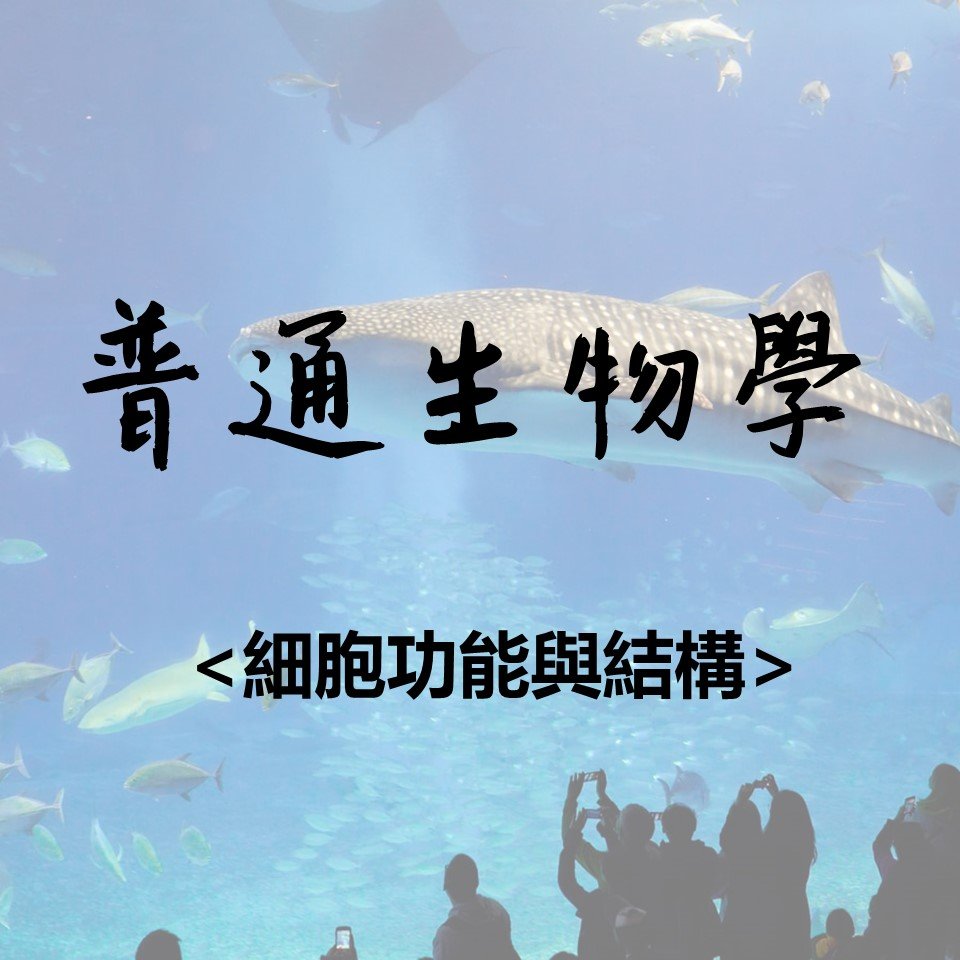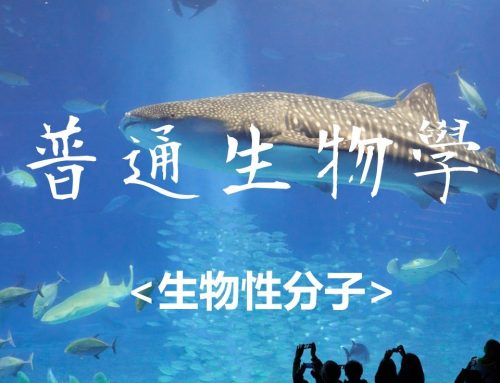普通生物學
細胞功能與結構

這一篇內容會比上一篇難一點,可以算是正式踏入普通生物學了,尤其是細胞骨架、內膜系統的概念,在能力競賽、生物奧林匹亞都算是滿常出現的,在閱讀時,請務必留意這幾個區塊。
老樣子,在文末一樣會放上幾題練習題,題目雖然是英文的,但只要把文章內的單字讀熟的話,閱讀上應該不會有問題。
| 目錄 |
細胞介紹
- 概述
- 細胞是生命的最基本單位
- 所有生物體皆由細胞組成
- 細胞是能獨立生存的最小單位
- 每個細胞都是由母細胞分裂而來
- 細胞間可能差異很大,但會有共同特徵
圖源取自:SEER Training
- 常見生物構造大小
- 植物細胞、動物細胞、微生物、胞器、細胞核:微米級,可用光學顯微鏡觀察
- 病毒、核醣體:奈米級,需要電子顯微鏡觀察
- Cell Fractionation (細胞分離)
- 目的:將細胞拆解及分離各個胞器(organelles)
- 方法:將細胞打碎之後進行離心
- 離心結果順序:由大到小,細胞殘骸→粒線體、葉綠體→……→核醣體
- 細胞的共同特徵
- 細胞膜(plasma membrane)
- 細胞質液(cytosol),細胞內的半物質流體
- 染色體(chromosomes)
- 核醣體(ribosomes)
- 原核(prokaryotic) vs真核(eukaryotic)
細胞核
- DNA 在細胞核(nucleus)中會纏繞、聚集成染色質(chromatin)
- 染色質=蛋白質+纏繞在蛋白質上的DNA
- 細胞分裂時,染色質濃縮聚集成染色體(chromosomes)
- 核仁(nucleolus)位於細胞核中,是核糖體 RNA(rRNA)轉錄、加工及進行組裝的場所
- 細胞核外有雙層的核膜(Nuclear envelope),另外,膜上有Nuclear pore(核孔)來管控細胞核和細胞質之間的物質進出。
Ribosomes(核醣體)
- 核醣體(ribosomes)是細胞的一種胞器,含有一大一小兩個次單元,分別是:
- 核糖體是細胞內蛋白質合成的場所,能讀取 mRNA的遺傳資訊,並使之轉化為胺基酸的序列,以合成蛋白質。簡而言之,核醣體就是要做蛋白質的。
- 核醣體又可以按照所在位置分為兩類:
- 游離型核醣體(free ribosome):散落在細胞質的核醣體
- 附著型核醣體(bound ribosome):位在內質網(endoplasmic reticulum、縮寫:ER)上的核醣體,或是位在核膜(nuclear envelope)上的核醣體。
The Endomembrane System (內膜系統)
- 內膜系統成員(超重要、每年生奧必考,一定要背!)
- Nuclear envelope(核膜)
- Endoplasmic reticulum(內質網)
- Golgi apparatus(高基氏體)
- Lysosomes(溶體)
- Vacuoles(液泡)
圖源取自:byjus

- 功能:調控蛋白質的製造與運輸,並且在細胞中表現許多代謝功能。
- 聯繫:彼此間有的互相連接,有的則利用 vesicle(囊泡)來運送物質與聯繫。
- 內膜系統成員個論
- Nuclear envelope(核膜):由兩層磷脂雙分子層構成
- Endoplasmic reticulum(內質網)
- 生化合成的工廠
- 和核膜相連
- 分為 Rough ER(粗糙內質網、rER)與 Smooth ER(平滑內質網、sER)
- Rough ER(粗糙內質網)
- 有Ribosomes (核醣體)附著
- 合成並分泌glycoprotein(醣蛋白),為蛋白質與carbohydrate 共價結合的產物
- 製造細胞裡的膜狀物質
- 其上有許多 transport vesicles(運輸物質的囊泡)
- Smooth ER(平滑內質網)
- 無Ribosomes (核醣體)附著
- 合成並分泌lipids(脂質)
- 代謝carbohydrates(醣類)
- 解毒(包括藥物或毒物)
- 儲存calcium ion(鈣離子)
- Rough ER(粗糙內質網)
- Golgi apparatus(高基氏體)
- 接受及傳輸 vesicle 出去的中心
- 功能為修飾ER的產物、合成一些 macromolecule(大分子)、將物質分類並打包行成 transport vesicle(囊泡)
- 由許多扁平的囊狀膜組成,這些囊狀膜稱為 cisternae,又可分為兩面
- Cis face(面向nucleus):golgi apparatus 的接受側。
- Trans face(面向細胞膜):golgi apparatus 的輸出側。
- Lysosomes (溶體)
- 含許多水解酶(Lysosomal enzyme)的囊腔,可消化許多大分子物質
- 水解酶可以水解蛋白質、脂肪、多醣類與核酸
- 水解酶於酸性環境中可達最佳效用
- Lysosome 的胞內消化可分為兩種:
- Phagocytosis(吞噬作用):將病原體、小分子物質……吞噬形成 food vacuole(食泡),再與lysosome融合,而後水解酶再發揮效用
- Autophagy(自噬作用):Lysosome和老化的胞器融合,水解酶再將其分解,回收物質並再利用。
- Vacuole (液泡)
Mitochondria (粒線體) 和Chloroplast (葉綠體)
- 通論:
- Mitochondria (粒線體) 和Chloroplast (葉綠體)都可以轉換能量的形式。
- Mitochondria(粒線體)為細胞呼吸作用、產生能量的場所
- Chloroplast (葉綠體),可以在植物或藻類中找到,可以進行photosynthesis(光合作用)
- Mitochondria
- 粒線體幾乎可在所有真核生物細胞內找到
- 為細胞呼吸的場所,可利用 O 2製造 ATP。
- 構造:
- 雙層膜的胞器,分為內膜和外膜。
- 有平滑的 outer membrane(外膜)。
- Inner membrane (內膜)上有許多皺褶,形成向內凹陷的結構,我們稱這種結構為cristae,這樣的結構能使呼吸作用的表面基增大,利於ATP形成。
- Inner membrane 製造了兩個空間,分別是 intermembrane space(膜間腔→內膜和外膜所夾的空間)以及mitochondrial matrix(粒線體基質)
- 某些細胞呼吸的代謝作用會在粒線體基質被催化
圖源取自:Molecular Expressions
- Chloroplast (葉綠體)
- 構造:
- Thylakoid(類囊體):很多個類囊體疊在一起可形成 granum (葉綠餅)
- Stroma(基質):葉綠體內的液體。
圖源取自:Britannica
- stroma 中含有葉綠體 DNA 及核醣體
- 葉綠體可在植物的葉子或是綠色的器官及藻類中存在。
- 葉綠體具有綠色色素 chlorophyll(葉綠素)、酵素以及進行 photosynthesis (光合作用)的分子
- 構造:
- The Endosymbiont theory(內共生假說)
Peroxisome (過氧化體)
- Peroxisome 為具單層膜的特化的代謝部位,具很多氧化酶。
- Peroxisome 的酵素可以產生H 2 O 2 ,也可以把過氧化氫轉換成水。
- 過氧化體和很多反應有關,如:解毒、分解脂肪酸。
- 不歸類在內膜系統。(這個有夠重要、有夠常考)
- 過氧化體和其他胞器的關係仍不清楚。
Cytoskeleton (細胞骨架)(重要)
- 細胞骨架是整個細胞質的纖維網路。
- 它可以固定細胞形狀、控制細胞活動、固定胞器的位置、負責細胞內囊泡的移動
- 細胞骨架的種類(由大到小):
- Microtubules (微管)
- 細胞分裂時,幫助染色體的移動,並形成Spindle fibers(紡錘絲)、(Aster星狀體)、Centrioles(中心粒)
- 可形成flagellum(鞭毛)、cilia(纖毛)
- 可協助細胞內囊泡的移動
- Intermediate Filaments (中間絲)
- 直徑約8-12奈米
- 維持細胞的形狀
- 固定胞器的位置
- 比微絲、微管持久
- Microfilaments (微絲)
- 抵抗細胞內張力及拉力
- 使小腸的microvilli(微絨毛)可伸縮運動
- Amoeboid (變形蟲) 運動:助變形蟲伸出偽足
- Myosin (肌凝蛋白) 可以協助肌肉的收縮
- Cytoplasmic streaming (細胞質流):在植物體中,葉綠體會循一定方向流動,又稱為原生質流
圖源取自:AP Biology
- Microtubules (微管)
Extracellular Components (細胞外成分)
- 大多數的細胞會產生、分泌物直到細胞膜外,這樣的東西就是Extracellular Components
- 細胞外的常見成分有:
- 植物的細胞壁
- 細胞壁存在於細胞膜的外側
- Prokaryotes (原核生物)、fungi (真菌) 和部分protists (原生生物)也有細胞壁。
- 細胞壁可以維持細胞形狀、保護細胞、防止吸收過多水分
- 植物的細胞壁又可以分成三層:
- Primary cell wall (初級細胞壁):最薄也最有彈性
- Middle lamella (中膠層):相鄰細胞的初級細胞壁間、薄薄的一層
- Secondary cell wall (次級細胞壁):有些細胞才有,位於細胞膜和初級細胞壁之間。
- 動物的extracellular matrix (ECM、胞外基質)
- 由glycoproteins (醣蛋白)組成,常見的醣蛋白有collagen (膠原蛋白)、proteoglycans (蛋白多糖) 和fibronectin (纖維連接蛋白)
- 當ECM和細胞上的受體連接時,又稱為integrin (整合素)。
- Intercellular junctions(細胞間接合物)
- 植物的細胞壁
結論
- 細胞可以協調細胞內的胞器作用,使胞器們達到1+1>2的成果。
延伸練習
我有從網路上找了大約10題的練習題,此部分的題目雖然是英文的,不過如果把文內的單字都背熟應該都看得懂,大家不用太擔心,有興趣的可以當作是個自我檢測,如果下面的題目你都能搞懂,代表你已經有抓到核心概念了。
- A cell with a predominance of free ribosomes is most likely
A) producing primarily proteins for secretion.
B) producing primarily cytoplasmic proteins.
C) constructing an extensive cell wall or extracellular matrix.
D) digesting large food particles.
E) enlarging its vacuole.Answer: B
2.Which structure is the site of the synthesis of proteins that may be exported from the cell?
A) rough ER
B) lysosomes
C) plasmodesmata
D) Golgi vesicles
E) free cytoplasmic ribosomesAnswer: A
- Which of the following statements correctly describes some aspect of protein secretion from prokaryotic cells?
A) Prokaryotes are unlikely to be able to secrete proteins because they lack an endomembrane system.
B) The mechanism of protein secretion in prokaryotes is probably the same as that in eukaryotes.
C) Proteins that are secreted by prokaryotes are synthesized on ribosomes that are bound to the cytoplasmic surface of the plasma membrane.
D) In prokaryotes, the ribosomes that are used for the synthesis of secreted proteins are located outside of the cell.
E) Prokaryotes contain large pores in their plasma membrane that permit the movement of proteins out of the cell.Answer: C
- Which of the following produces and modifies polysaccharides that will be secreted?
A) lysosome
B) vacuole
C) mitochondrion
D) Golgi apparatus
E) peroxisomeAnswer: D
- Why isn’t the mitochondrion classified as part of the endomembrane system?
A) It is a static structure.
B) Its structure is not derived from the ER or Golgi.
C) It has too many vesicles.
D) It is not involved in protein synthesis.
E) It is not attached to the outer nuclear envelope.Answer: B
- Centrioles, cilia, flagella, and basal bodies have remarkably similar structural elements and arrangements. Which of the following hypotheses is most plausible in light of such structural similarities?
A) Cilia and flagella arise from the centrioles.
B) Loss of basal bodies should lead to loss of all cilia, flagella, and centrioles.
C) Motor proteins such as dynein must have evolved before any of these four kinds of structure.
D) Cilia and flagella coevolved in the same ancestral eukaryotic organism.
E) Natural selection for cell motility repeatedly selected for microtubular arrays in circular patterns in the evolution of each of these structures.Answer: A
- When a potassium ion (K+) moves from the soil into the vacuole of a cell on the surface of a root, it must pass through several cellular structures. Which of the following correctly describes the order in which these structures will be encountered by the ion?
A) plasma membrane → primary cell wall → cytoplasm → vacuole
B) secondary cell wall → plasma membrane → primary cell wall → cytoplasm → vacuole
C) primary cell wall → plasma membrane → cytoplasm → vacuole
D) primary cell wall → plasma membrane → lysosome → cytoplasm → vacuole
E) primary cell wall → plasma membrane → cytoplasm → secondary cell wall → vacuoleAnswer: C
- Plasmodesmata in plant cells are most similar in function to which of the following structures in animal cells?
A) peroxisomes
B) desmosomes
C) gap junctions
D) extracellular matrix
E) tight junctionsAnswer: C
- ECM proteins are made by ribosomes in which part of a eukaryotic cell?
A) mitochondria
B) cytoplasm
C) nuclear envelope
D) Golgi apparatus
E) rough ERAnswer: E
- What is the most likely pathway taken by a newly synthesized protein that will be secreted by a cell?
A) ER → Golgi → nucleus
B) Golgi →ER →lysosome
C) nucleus →ER →Golgi
D) ER →Golgi →vesicles that fuse with plasma membrane
E) ER →lysosomes →vesicles that fuse with plasma membraneAnswer: D


這個真的好有用
選生的救星
凡鳥從來不會讓我失望
哈哈哈哈,有幫助就好啦!覺得不錯的話也可以分享給朋友~